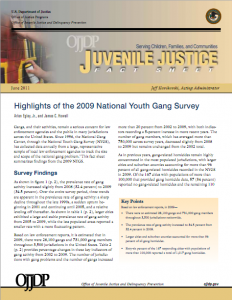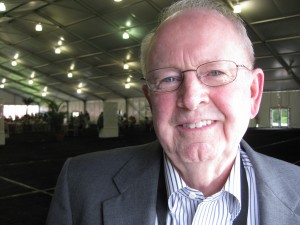ORLANDO, Fla, - Frontline practitioners working on gang prevention, intervention and suppression are gathered this week for the National Gang Symposium in Orlando, Fla. For prevention, think of the Boys & Girls Club. For intervention, think of the Los Angeles-based Homeboy Industries, whose motto is “nothing stops a bullet like a job.” And for suppression, well, of course, think of the police.
The number crunchers from the National Gang Center, using their own just released data, are telling symposium attendees today that gangs remain a substantial problem in the nation. However, gang levels are lower than the peak levels in the mid-1990s, and law enforcement agencies reported gang activity in their jurisdictions at about the same levels for five straight years – all this during a time when overall violence is way down.

Read the full fact sheet here.
Arlen Egley, one of those National Gang Center number crunchers, is learning something in return from the police at the symposium. A common theme among law enforcement is, “We can’t arrest our way of this problem." And Egley added, “It is reassuring to hear that.”
The symposium’s clarion call is that total collaboration among prevention, intervention and suppression folks will make a difference. James “Buddy” Howell, also from the National Gang Center, said that to reduce gang activity the community at large will have to be better organized than the gangs themselves.

Arlen Egley
Luis J. Rodriquez, speaker, author, and former Los Angeles gang member, said gang members call it “La Vida Loca" (the crazy life) because even they know it as a crazy existence. The brains of gang members in their teens and early 20s are not fully developed, he noted, and still can be molded for good or bad.
“Unfortunately,” Rodriquez said, “that’s the time we want to put them away.” Thus prison life often determines who they will become.
Sticking with the dominant symposium theme of full community support, Rodriquez provided five prescriptions for helping kids break away from the crazy web of gang life: Provide help and community; aid them in making spiritual connections beyond gang loyalty; give them a cause bigger than themselves, which might simply be how to be a good mother or father; find the art within which could be the creative arts or the art of teaching or being a mechanic; and finally, they have to learn to run their own lives because “taking full responsibility is a powerful, liberating thing.”
Finn-Aage Esbensen, a criminology professor at the University of Missouri-St. Louis, told the story of a European saying Europe doesn’t have gangs like we do in the United States, and the U.S. researcher responded, “neither do we.” He meant traditional, long standing, gangs like the Crips and the Bloods are mostly confined a few large cities like Los Angeles and Chicago. Most gangs in smaller towns come and go and often kids are in and out within a year. Plus, a Korean gang is different from a motorcycle gang and a Chinese gang is different from Hispanic gang, and so on.

James (Buddy) Howell
The cops, social workers, youth workers and probation officers on the panels used the terms research, data, empirical evidence, goals and measurable outcomes so often that the conference had the ring of academia. Indeed, Kelly McMillan, assistant chief of police in Salinas, Calif., said his department has tapped the Naval Postgraduate School in nearby Monterey to learn — via evidence-based research, of course — what lessons from fighting insurgents in places like Afghanistan can be applied to their local gang problem.
Of course, much of that evidence-based talk is driven by funders who want measurable outcomes, and everyone needs more funds. A woman next to this reporter at lunch just heard that six people at her intervention nonprofit just got laid off.
Hector Verdugo, associate executive director of Homeboy Industries, said, “Our biggest problem is the funding.” The lack of funding has produced a three-month waiting list among the 8,000 gang members who come to Homeboy Industries annually to build a new life. That number Verdugo says is 8,000 out of the estimated 80,000 gang members in Los Angeles County.
Speaking like the long-time gang researchers they are, Howell and Egley say that if you do proper assessments of the gang problems, know the amount of involvement and their threats, then you can put your limited funds where they can have the best effect. If you want to learn how to get there, you might want to read Howell's paper entitled: Gang Prevention: An Overview of Research and Programs.
